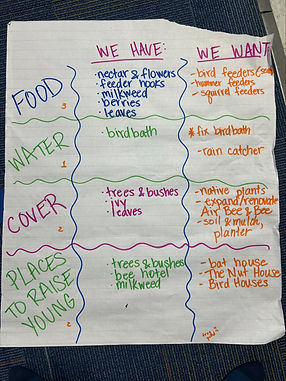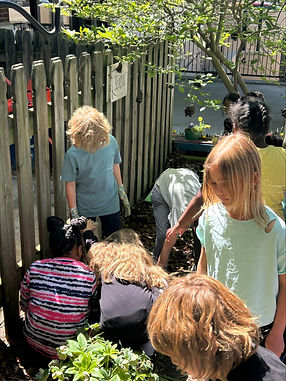
Window of Opportunity Grant Project

The Downtown School
601 N Cherry St #601, Winston-Salem, NC 27101
Forsyth County
Project: Native Garden Enrichment
Application Request/Project Summary:
The purpose of this project is to empower students to create and maintain a sustainable wildlife habitat at The Downtown School, fostering environmental stewardship, hands-on learning, and a deeper connection to nature. This initiative will provide students with the opportunity to engage in real-world conservation efforts, while enhancing the school grounds with native plants, birdhouses, pollinator gardens, and other wildlife-friendly features. By working collaboratively, students will develop valuable skills in ecology, teamwork, and environmental responsibility, while contributing to the local biodiversity and creating a green space that benefits both the school community and local wildlife.
Students will create spaces that support flora and fauna native to the state of North Carolina while educating and empowering our students to turn our campus into a thriving urban habitat for birds, insects, and other wildlife. Our students will work together to plan for these spaces on our campus, organize volunteer efforts for renovation, implement their plans as a community, and learn about the key elements necessary to attract wildlife to our campus. Students will determine the best options for incorporating food sources, cover sources, water sources, and places for wildlife to raise their young in the space available on our school campus.
Narrative Scope of Work:
This project will engage students in the design, creation, and ongoing maintenance of a wildlife habitat on the grounds of their urban school campus at The Downtown School in Winston-Salem, NC. The scope of work is divided into three phases: Planning and Design, Implementation, and Education and Maintenance.
Phase 1: Planning and Design
-
Student Engagement: The project will begin with classroom sessions, led by teachers and local environmental experts, where students in second through fifth grades will learn about native species, local ecosystems, and the benefits of wildlife habitats. Students will then participate in the design process, identifying key areas of the school grounds to develop into wildlife-friendly spaces, as well as determining components of wildlife habitats that are already in place.
-
Habitat Planning: Students will research and select native plants, trees, and shrubs that support local wildlife such as pollinators, birds, and small mammals. They will also design features such as birdhouses, bird feeders, a bat house, butterfly gardens, and water sources to attract diverse wildlife.
-
Partnerships: The school will collaborate with the local cooperative extension office, who will provide guidance and resources to support the design phase.
Phase 2: Implementation
-
Site Preparation: Students, teachers, and parent volunteers will work together to prepare the designated areas of the school grounds by clearing invasive species and preparing soil for planting. This work will include creating garden beds, building and installing birdhouses, bathouses, and birdfeeders, and creating a water feature.
-
Planting and Installation: Students will plant native vegetation and install the wildlife features designed in the planning phase, including pollinator gardens, bird feeders, and a ater station for animals. Students will also engage in creating signage to educate the broader school community about the habitat and the species it supports.
-
Ongoing Collaboration: Volunteers will help with the installation of larger features and ensure proper planting techniques are used.
Phase 3: Education and Maintenance
-
Educational Programming: Following the completion of the habitat, students will conduct guided tours of the habitat for the school community, explaining how the habitat supports biodiversity and what they have learned about conservation.
-
Maintenance Plan: Students will develop a maintenance plan to ensure the habitat thrives year-round, including watering plants, removing invasive species, monitoring wildlife activity, and seasonal clean-ups. Teachers, students, and parent volunteers will take turns overseeing these tasks, integrating them into regular classroom activities.
-
Certification: Students will submit an application to designate the space as a Certified NC Wildlife Habitat through the North Carolina Wildlife Federation.
Throughout the project, students will have the opportunity to take ownership of the habitat, developing a sense of environmental responsibility and leadership. By providing a space where local wildlife can thrive, this project will foster a deeper understanding of ecological balance and encourage lifelong conservation efforts.
Native Garden Enrichment
Project Site Photos
KNCB Visit/Pre-project
















Project Development & Completion Photos












